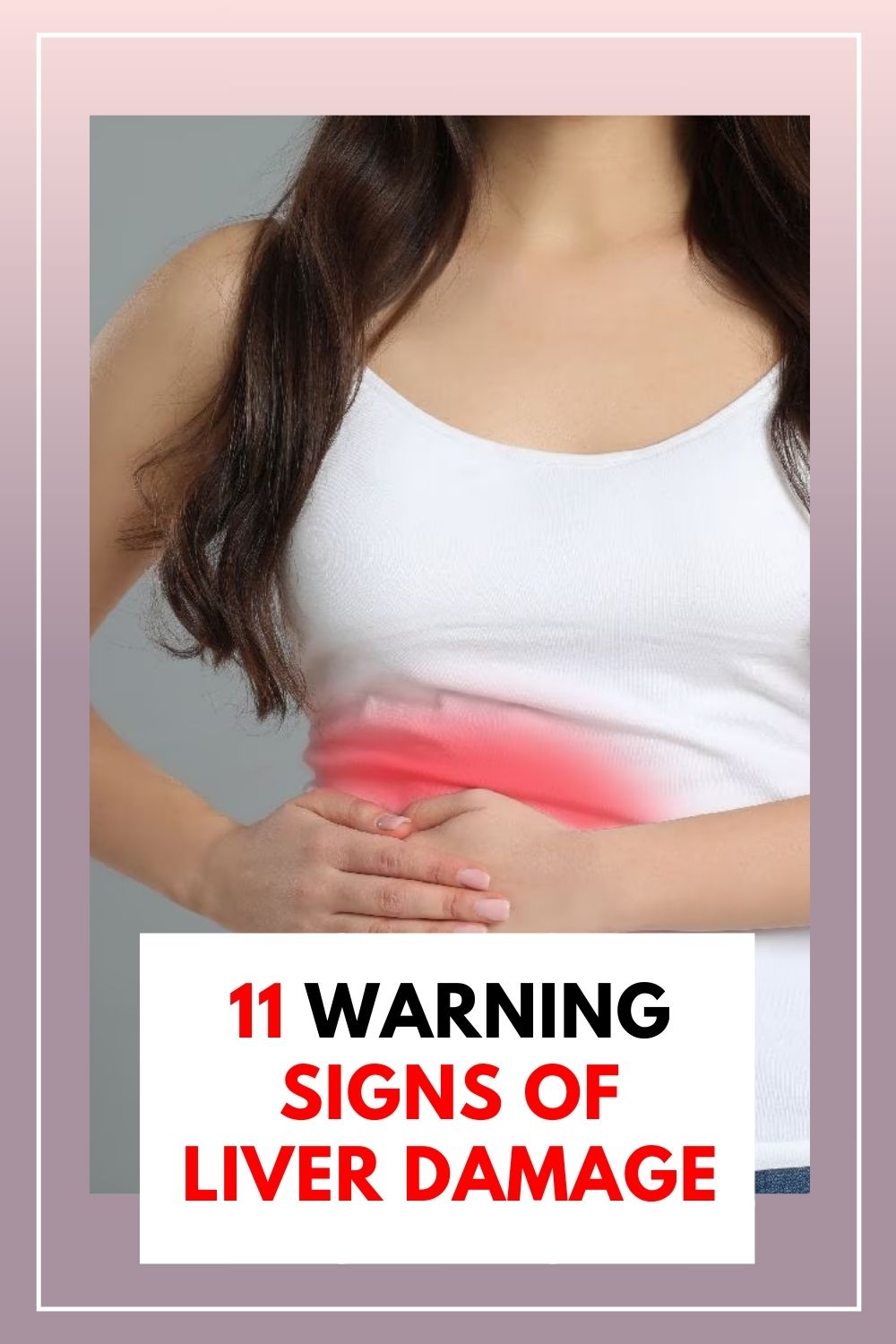Liver damage is a serious medical condition with severe consequences if left untreated. The liver is an essential organ that helps the body filter toxins, produce bile, and store energy. When the liver is damaged, it can affect the body’s overall health and lead to chronic disease.
Individuals should be aware of various warning signs of liver damage. These symptoms may include fatigue, nausea, abdominal pain, and jaundice.
Sometimes, liver damage may not show symptoms until the disease progresses significantly. Therefore, it’s essential to be aware of the risk factors that can lead to liver damage, such as excessive alcohol consumption, obesity, and viral hepatitis.
Jaundice
Jaundice is a common symptom of liver damage and failure. It is characterized by yellowing skin and eyes and is caused by an excess of bilirubin in the blood. Bilirubin is the liver’s waste when it breaks down old red blood cells.
Typically, the liver processes bilirubin and excretes it in the bile, which is then eliminated from the body through the feces. However, when the liver is damaged, it may not process bilirubin properly, leading to a buildup in the blood.
Jaundice can be caused by a variety of liver diseases, including hepatitis B and C, hepatocellular carcinoma, and damage to the bile ducts. It can also be an early sign of liver damage and may be accompanied by other symptoms such as fatigue, nausea, and loss of appetite.
Here are some key points to remember about jaundice and liver damage:
- Jaundice is a common symptom of liver damage and liver failure.
- It is caused by an excess of bilirubin in the blood, which can occur when the liver is damaged.
- Jaundice can be caused by a variety of liver diseases, including hepatitis B and C, hepatocellular carcinoma, and damage to the bile ducts.
- It can also be an early sign of liver damage and may be accompanied by other symptoms such as fatigue, nausea, and loss of appetite.
- If left untreated, jaundice can lead to severe complications, including liver failure and death.
- Treatment will depend on the underlying cause of the liver damage and may include medications, lifestyle changes, and, in some cases, liver transplants.
Belly Pain and Swelling
Belly pain and swelling are common symptoms of liver damage, particularly in the later stages of liver disease. When the liver is damaged, it can no longer function properly, leading to fluid buildup in the abdomen, a condition known as ascites. This fluid buildup can cause the belly to become swollen and painful.
In addition to ascites, belly pain and swelling can also be caused by portal hypertension, a condition where the blood flow through the liver is obstructed, leading to increased pressure in the veins that carry blood to the liver. This increased pressure can cause the veins in the esophagus and stomach to enlarge, leading to bleeding and further abdominal swelling.
Belly pain and swelling can also be a symptom of liver cancer, which can develop as a result of chronic liver inflammation. In some cases, liver cancer can cause the liver to become enlarged, leading to abdominal swelling and discomfort.
Swelling in the Legs and Ankles
Swelling in the legs and ankles, also known as edema, can be a warning sign of liver damage. The liver plays a crucial role in regulating the fluid balance in the body.
When the liver is damaged, it can’t produce enough albumin, a protein that helps keep fluid in the bloodstream. As a result, fluid can accumulate in the legs and ankles, causing swelling.
Swelling in the legs and ankles can be a symptom of many liver conditions, including cirrhosis, chronic liver failure, and portal hypertension. In cirrhosis, the liver becomes scarred and cannot function properly. This can lead to fluid buildup in the abdomen, a condition known as ascites. Ascites can cause swelling in the legs and ankles and other symptoms such as abdominal pain and bloating.
Portal hypertension, a condition in which the blood pressure in the liver is abnormally high, can also cause swelling in the legs and ankles. The increased pressure can force fluid out of the blood vessels and into the surrounding tissues.
In addition to swelling, other symptoms of liver damage may include fatigue, weakness, weight loss, nausea, bruising or bleeding easily, itchy skin, and spider-like blood vessels on the skin.

Itchy Skin
Itchy skin is a common symptom of liver disease, particularly in cases of primary biliary cholangitis, cholestasis, and autoimmune hepatitis.
Itching without a rash may also be a side effect of certain medications, including opioids, statins, and blood pressure drugs. Skin conditions such as eczema and psoriasis can also cause itching and a rash.
Liver disease can cause itching due to the accumulation of bile salts under the skin. Elevated bile salts can cause itching, although not all patients with liver disease experience itching.
Activation of opioid receptors in the body may also cause itching due to interference with pain signaling. Elevated serotonin levels are also believed to cause itch by altering itch signaling.
Itchy skin can be a warning sign of liver damage, and a person should speak with a doctor if they experience itching that is not relieved by over-the-counter treatments. A doctor can perform tests to determine the underlying cause of the itching and develop a treatment plan.
Dark Urine
One of the most common warning signs of liver damage is dark urine. This can be a symptom of several liver diseases, including hepatitis, cirrhosis, and liver cancer. Dark urine is caused by an excess of bilirubin, a yellow pigment produced when red blood cells are broken down.
When the liver is damaged, it may not be able to process bilirubin properly, leading to an excess of the pigment in the bloodstream. This excess can cause the urine to become dark in color. In some cases, the urine may also have a strong odor.
To determine the underlying cause of dark urine, a doctor may perform a blood test to check for elevated bilirubin levels. They may also perform imaging tests, such as an ultrasound or CT scan, to look for signs of liver damage.
If liver damage is the cause of dark urine, treatment will depend on the underlying condition. In some cases, lifestyle changes such as avoiding alcohol and maintaining a healthy weight can help slow the progression of liver damage. In more severe cases, medications or surgery may be necessary.
Pale Stool
The pale or clay-colored stool is a common symptom of liver damage and can indicate a severe underlying problem. The color of stool is typically determined by the presence of bile, produced by the liver and stored in the gallbladder. When bile production is disrupted, stool can appear pale or clay-colored.
There are several reasons why bile levels may be decreased. In liver disease, such as hepatitis A or C, the liver becomes inflamed and can no longer function properly. This can lead to a decrease in bile production and a change in the color of stool. In addition, blockages in the bile ducts can also cause pale stool.
To diagnose the underlying cause of pale stool, a doctor may order blood tests to check liver function and imaging tests such as an ultrasound or CT scan. Treatment will depend on the underlying cause of the liver damage and may include medication, lifestyle changes, or, in some cases, surgery.
Constant Tiredness
One of the most common warning signs of liver damage is constant tiredness. Fatigue is a common symptom of liver disease, and various factors can cause it. Hepatic encephalopathy, cirrhosis, chronic hepatitis B, and chronic hepatitis C can all cause fatigue in individuals with liver damage.
Fatigue is a feeling of tiredness or exhaustion caused by physical or mental exertion. When the liver is damaged, it can no longer function properly, leading to a buildup of toxins in the body. These toxins can cause fatigue and other symptoms.
In addition to fatigue, individuals with liver damage may also experience other symptoms such as loss of appetite, nausea, discomfort, or mild pain in the upper right abdomen. It is essential to seek medical attention if you are experiencing any of these symptoms, especially if they are persistent or severe.
Nausea or Vomiting
Nausea and vomiting are common symptoms of liver damage. When the liver cannot filter toxins in the blood, it can lead to nausea and vomiting. This is because toxins build up in the body and affect the gastrointestinal system, leading to discomfort and nausea.
Liver damage can cause gastrointestinal issues such as bloating, constipation, and diarrhea. These symptoms are often accompanied by nausea and vomiting, making it difficult to eat or drink anything.
Infection can also cause nausea and vomiting, which can be a sign of liver damage. Hepatitis, for example, can cause inflammation and damage to the liver, leading to nausea and vomiting.
If you are experiencing nausea and vomiting along with other symptoms such as abdominal pain, yellowing of the skin or eyes, and fatigue, it is essential to seek medical attention. These symptoms may indicate liver damage or other serious health issues.
Loss of Appetite
One of the warning signs of liver damage is a loss of appetite. This symptom is common in people with liver disease, cirrhosis, hepatitis, and liver cancer.
When the liver is damaged, it can’t produce enough bile, which is needed to digest fats. This can lead to a feeling of fullness, loss of appetite, and weight loss. In addition, the liver also plays a role in regulating blood sugar levels. When the liver is damaged, it can’t store and release glucose properly, leading to low blood sugar levels, which can also cause a loss of appetite.
There are several reasons why liver damage can cause a loss of appetite. For example, liver disease can cause inflammation in the liver, which can lead to nausea, vomiting, and a loss of appetite. In addition, liver damage can cause changes in the way the body metabolizes nutrients, making it harder to digest food and absorb nutrients.
Bruising Easily
One of the warning signs of liver damage is bruising easily. The liver is essential in producing clotting factors that help stop bleeding. When the liver is damaged, it can’t make enough clotting factors, leading to easy bruising and bleeding.
Liver disease, including hepatitis C, can damage the liver and affect clotting ability. Blood tests can reveal whether the liver functions correctly and produces enough clotting factors. If the liver is damaged, a deficiency in clotting factors can result, resulting in easy bruising.
Frequently Asked Questions
What are the early symptoms indicating potential liver damage?
Early symptoms of liver damage include fatigue, weakness, loss of appetite, and nausea. Other signs include abdominal pain, unexplained weight loss, and yellowing of the skin and eyes (jaundice).
Which signs suggest that the liver might be failing?
Abdominal swelling, confusion, and easy bruising or bleeding are signs that the liver might be failing. Dark urine, light-colored stools, and itching can also indicate liver failure.
How can one identify liver damage due to medication?
Liver damage caused by medication can be identified by symptoms such as fatigue, nausea, vomiting, abdominal pain, and yellowing of the skin and eyes. Blood tests can also help diagnose liver damage caused by medication.
What are the indications of a liver in distress?
Indications of a liver in distress include abdominal pain, fatigue, nausea, and yellowing of the skin and eyes (jaundice). Additionally, fluid buildup in the abdomen, confusion, and bleeding can also indicate a liver in distress.
What symptoms are commonly experienced by women with liver failure?
Women with liver failure may experience symptoms such as abdominal swelling, fatigue, and nausea. Additionally, they may experience hormonal imbalances, irregular periods, and infertility.
How does the body signal that the liver is overburdened?
The body signals that the liver is overburdened through fatigue, abdominal pain, and nausea. Additionally, yellowing of the skin and eyes (jaundice), dark urine, and light-colored stools can indicate an overburdened liver.

 Melinda Miles is a courageous fibromyalgia warrior living with the condition for over 10 years. She is an advocate and voice in the fibromyalgia community, having created an online blog, TheFibrowarriors.com, to provide education, support, and community for those affected by this often misunderstood condition.
Melinda Miles is a courageous fibromyalgia warrior living with the condition for over 10 years. She is an advocate and voice in the fibromyalgia community, having created an online blog, TheFibrowarriors.com, to provide education, support, and community for those affected by this often misunderstood condition.